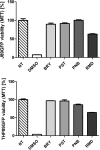Polyanionic carbosilane dendrimers as a new adjuvant in combination with latency reversal agents for HIV treatment
- PMID: 31113488
- PMCID: PMC6529996
- DOI: 10.1186/s12951-019-0500-4
Polyanionic carbosilane dendrimers as a new adjuvant in combination with latency reversal agents for HIV treatment
Abstract
Background: The major obstacle impeding human immunodeficiency virus-1 (HIV-1) eradication in antiretroviral treatment (ART) treated HIV-1 subjects is the establishment of long-lived latently infected resting CD4+ T cells. Due to the fact that no drug has been effective, the search for new drugs and combinations are a priority in the HIV cure. Treatments based on nanotechnology have emerged as an innovative and promising alternative to current and conventional therapies. In this respect, nanotechnology opens up a new door for eliminating latent HIV infection. We studied the role of G1-S4, G2-S16 and G3-S16 polyanionic carbosilane dendrimers in the context of latent HIV-1 persistence. Moreover, we study the efficiency of these dendrimers in combination with latency reversal agents (LRAs) against HIV-1 infection.
Methods: J89GFP lymphocyte and THP89GFP monocyte derived cell lines latently infected with HIV-1 p89GFP were used as an in vitro model of latency for our study. Viability assays by 3-(4-5-dimethylthiazol-2-yl)-2,5-diphenyltetrazolium bromide (MTT) and lactate dehydrogenase (LDH) were performed to determine the working concentrations of dendrimers and LRAs. Both cell lines were treated with G1-S4, G2-S16 and G3-S16 either alone or in combination with bryostatin (BRY), romidepsin (RMD) or panobinostat (PNB) for 24 and 48 h. The expression pattern of GFP was measured by flow cytometry and referred as measure of viral reactivation.
Results and discussion: The combination treatment of the dendrimers with the protein kinase C (PKC) agonist did not modify the antilatency activity in J89GFP lymphocyte cell line. Interestingly enough, G3-S16 dendrimer alone and its combination with BRY, RMD or PNB showed a significant increased expression of GFP in the THP89GFP monocyte cell line.
Conclusion: We showed for the first time that nanoparticles, in this case, G3-S16 anionic carbosilan dendrimer may play an important role in new treatments against HIV-1 infection.
Keywords: Dendrimers; HIV-1 latency; Latency reversal agents; Nanomedicine.
Conflict of interest statement
The authors declare that they have no competing interests.
Figures






Similar articles
-
Synergistic Activation of Latent HIV-1 Expression by Novel Histone Deacetylase Inhibitors and Bryostatin-1.Sci Rep. 2015 Nov 13;5:16445. doi: 10.1038/srep16445. Sci Rep. 2015. PMID: 26563568 Free PMC article.
-
Anionic Carbosilane Dendrimers Destabilize the GP120-CD4 Complex Blocking HIV-1 Entry and Cell to Cell Fusion.Bioconjug Chem. 2018 May 16;29(5):1584-1594. doi: 10.1021/acs.bioconjchem.8b00106. Epub 2018 Mar 30. Bioconjug Chem. 2018. PMID: 29570280
-
G2-S16 sulfonate dendrimer as new therapy for treatment failure in HIV-1 entry inhibitors.Nanomedicine (Lond). 2019 May;14(9):1095-1107. doi: 10.2217/nnm-2018-0364. Epub 2019 May 8. Nanomedicine (Lond). 2019. PMID: 31066644
-
Polyanionic carbosilane dendrimer-conjugated antiviral drugs as efficient microbicides: Recent trends and developments in HIV treatment/therapy.Nanomedicine. 2015 Aug;11(6):1481-98. doi: 10.1016/j.nano.2015.03.008. Epub 2015 Mar 31. Nanomedicine. 2015. PMID: 25835558 Review.
-
Emergence of Nanotechnology to Fight HIV Sexual Transmission: The Trip of G2-S16 Polyanionic Carbosilane Dendrimer to Possible Pre-Clinical Trials.Int J Mol Sci. 2020 Dec 10;21(24):9403. doi: 10.3390/ijms21249403. Int J Mol Sci. 2020. PMID: 33321835 Free PMC article. Review.
Cited by
-
Promising PEGylated cationic dendrimers for delivery of miRNAs as a possible therapy against HIV-1 infection.J Nanobiotechnology. 2021 May 28;19(1):158. doi: 10.1186/s12951-021-00899-0. J Nanobiotechnology. 2021. PMID: 34049570 Free PMC article.
-
Diversity of small molecule HIV-1 latency reversing agents identified in low- and high-throughput small molecule screens.Med Res Rev. 2020 May;40(3):881-908. doi: 10.1002/med.21638. Epub 2019 Oct 13. Med Res Rev. 2020. PMID: 31608481 Free PMC article. Review.
-
Applications and Limitations of Dendrimers in Biomedicine.Molecules. 2020 Sep 1;25(17):3982. doi: 10.3390/molecules25173982. Molecules. 2020. PMID: 32882920 Free PMC article. Review.
-
G2-S16 Polyanionic Carbosilane Dendrimer Can Reduce HIV-1 Reservoir Formation by Inhibiting Macrophage Cell to Cell Transmission.Int J Mol Sci. 2021 Aug 4;22(16):8366. doi: 10.3390/ijms22168366. Int J Mol Sci. 2021. PMID: 34445073 Free PMC article.
-
High Preventive Effect of G2-S16 Anionic Carbosilane Dendrimer against Sexually Transmitted HSV-2 Infection.Molecules. 2020 Jun 28;25(13):2965. doi: 10.3390/molecules25132965. Molecules. 2020. PMID: 32605185 Free PMC article. Review.
References
-
- Gutierrez C, Diaz L, Vallejo A, Hernandez-Novoa B, Abad M, Madrid N, et al. Intensification of antiretroviral therapy with a CCR1 antagonist in patients with chronic HIV-1 infection: effect on T cells latently infected. PLoS ONE. 2011;6(12):e27864. doi: 10.1371/journal.pone.0027864. - DOI - PMC - PubMed
-
- Gutierrez C, Hernandez-Novoa B, Vallejo A, Serrano-Villar S, Abad-Fernandez M, Madrid N, et al. Dynamics of the HIV-1 latent reservoir after discontinuation of the intensification of antiretroviral treatment: results of two clinical trials. AIDS. 2013;27(13):2081–2088. doi: 10.1097/QAD.0b013e328361d0e1. - DOI - PubMed
-
- Furumai R, Matsuyama A, Kobashi N, Lee KH, Nishiyama M, Nakajima H, et al. FK228 (depsipeptide) as a natural prodrug that inhibits class I histone deacetylases. Cancer Res. 2002;62(17):4916–4921. - PubMed
MeSH terms
Substances
Grants and funding
LinkOut - more resources
Full Text Sources
Medical
Research Materials

